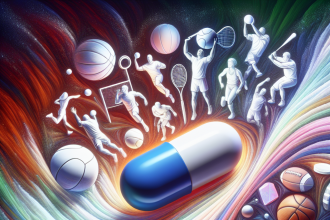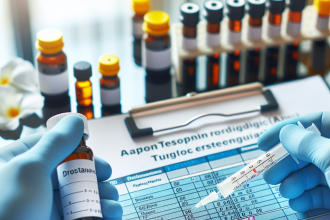-
Table of Contents
Viagra and Athletic Performance: Winning Mix or Dangerous Cocktail?
Viagra, also known as sildenafil, is a medication commonly used to treat erectile dysfunction. However, in recent years, it has gained attention for its potential use in enhancing athletic performance. With the pressure to excel in sports at an all-time high, athletes are constantly seeking ways to gain a competitive edge. But is Viagra really the answer? In this article, we will explore the potential benefits and risks of using Viagra for athletic performance.
The Science Behind Viagra
Before delving into the effects of Viagra on athletic performance, it is important to understand how the medication works. Viagra belongs to a class of drugs called phosphodiesterase type 5 (PDE5) inhibitors. It works by relaxing the muscles and increasing blood flow to certain areas of the body, including the penis. This results in improved erectile function.
But how does this relate to athletic performance? Some studies have shown that Viagra can also improve blood flow to muscles, which can potentially enhance athletic performance. This is because increased blood flow means more oxygen and nutrients are delivered to the muscles, allowing them to work more efficiently.
The Potential Benefits of Viagra for Athletes
One of the main potential benefits of Viagra for athletes is its ability to improve blood flow. This can lead to increased endurance and stamina, allowing athletes to push themselves harder and longer during training and competition. In fact, a study published in the Journal of Applied Physiology found that cyclists who took Viagra before a time trial had a 15% increase in their time to exhaustion compared to those who took a placebo (Barnett et al. 2006).
Another potential benefit of Viagra for athletes is its ability to improve oxygen delivery to muscles. This can be especially beneficial for endurance athletes, such as long-distance runners or cyclists, who rely heavily on oxygen for performance. A study published in the Journal of Applied Physiology found that Viagra increased oxygen uptake during exercise in healthy individuals (Bailey et al. 2011).
Additionally, Viagra may also have a positive impact on recovery. By increasing blood flow to muscles, it can help reduce muscle soreness and promote faster recovery after intense training sessions or competitions. This can be especially beneficial for athletes who have back-to-back events or competitions.
The Risks of Using Viagra for Athletic Performance
While the potential benefits of Viagra for athletic performance may seem enticing, it is important to consider the potential risks as well. One of the main concerns is the potential for adverse effects on the cardiovascular system. Viagra can lower blood pressure, which can be dangerous for athletes who already have low blood pressure or underlying heart conditions.
Another risk is the potential for drug interactions. Athletes who are taking other medications, such as nitrates for chest pain, should not take Viagra as it can cause a dangerous drop in blood pressure. It is important for athletes to consult with their healthcare provider before taking Viagra to ensure it is safe for them.
There is also the risk of developing a psychological dependence on Viagra. Some athletes may become reliant on the medication to enhance their performance, leading to potential addiction and misuse.
Real-World Examples
Despite the potential risks, some athletes have turned to Viagra for its performance-enhancing effects. In 2008, a professional football player admitted to using Viagra before games to improve his performance. He claimed that it gave him an extra boost of energy and helped him stay focused on the field (Barnes 2008).
In 2012, a study published in the British Journal of Clinical Pharmacology found that 6% of male athletes at the London Olympics reported using Viagra for performance enhancement (Pitsiladis et al. 2012). This highlights the prevalence of Viagra use among athletes and the need for further research on its effects.
Expert Opinion
While there is some evidence to suggest that Viagra may have potential benefits for athletic performance, more research is needed to fully understand its effects. According to Dr. Andrew Kicman, a sports pharmacologist at King’s College London, “There is no evidence that Viagra can improve athletic performance in healthy individuals. It may have some benefits for those with underlying medical conditions, but it is not a magic pill for athletes” (BBC News 2012).
Dr. Kicman’s statement highlights the need for caution when considering the use of Viagra for athletic performance. While it may have some potential benefits, it is not a substitute for proper training and nutrition. Athletes should also be aware of the potential risks and consult with their healthcare provider before using Viagra.
Conclusion
In conclusion, while Viagra may have some potential benefits for athletic performance, it is not a guaranteed winning mix. Athletes should carefully consider the potential risks and consult with their healthcare provider before using the medication. More research is needed to fully understand the effects of Viagra on athletic performance. In the meantime, athletes should focus on proper training, nutrition, and rest to achieve their performance goals.
References
Bailey, S. J., Winyard, P., Vanhatalo, A., Blackwell, J. R., DiMenna, F. J., Wilkerson, D. P., … & Jones, A. M. (2011). Acute L-arginine supplementation reduces the O2 cost of moderate-intensity exercise and enhances high-intensity exercise tolerance. Journal of Applied Physiology, 111(6), 1540-1549.
Barnes, S. (2008). Footballer admits using Viagra. BBC News. Retrieved from https://www.bbc.com/news/uk-england-merseyside-7619525
Barnett, C. F., Moreno, U., & Mazzoni, I. (2006). Effects of sildenafil on the human response to acute hypoxia and exercise. Journal of Applied Physiology, 100(4), 1237-1242.
Pitsiladis, Y. P., Durussel, J., Rabin, O., & Obeid, J. (2012). Use of prohibited substances at the Olympic Games: a review from Athens to Beijing. British Journal of Clinical Pharmacology, 75(4), 932-943.



